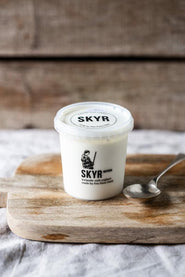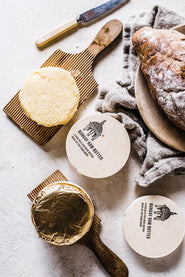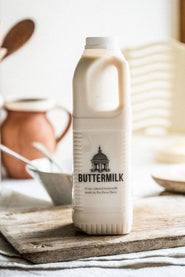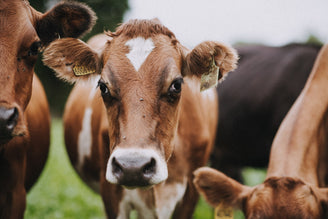The next time you are driving through the British countryside, take a moment to look around the farm gates you pass. Chances are you will spot a relic of our agricultural history, in the form of a modest stone platform. You’ve probably driven past them many times while in the countryside lanes and would be forgiven for not knowing what they are.
These are milk churn stands, designed to make the daily collection of milk simpler, as they were built to a standardised height for loading onto horse carts and later open-backed trucks, before milk tankers took over in the late 1970s. It was a common sight to see the matt, dented ten-gallon metal churns lined up on the roadside stands early in the morning following milking.
Now, long gone are the days when the countryside was a mosaic of such modest holdings where farmers kept a few dozen dairy cows as part of their mixed farming picture, with a set of milk churns being collected each day. By 1996 the average herd size was 75, today that’s closer to 205, with some indoor-only mega dairies counting cows in the thousands.
All this stacks up to the loss of a staggering 93% of UK dairy farms in the past 70 or so years.
In 1950, there were 196,000; in 2020, that number stood at 11,900. A significant part of that change has come in the form of modernisation as the average herd size has increased to make the most of the benefits of scale, which is an understandable necessity.
But with all that change, something has been lost within the milk itself. The reality is that milk is a seasonal product which reflects what the animal is eating as the farming year unfolds, from lush spring grass to deep-rooting herbal leys in summer, or forage crops of kale and beet in winter.

This is at odds with the economic realities of milk processing, transport and distribution, which dictate that most milk is blended, homogenised and standardised at enormous plants, to be distributed across the UK. As all individuality is lost as soon as the milk tanker pulls away from the farm, there is no incentive to craft a meaningful milk that reflects where it is from, as everything comes down to how much milk each cow can produce over anything else. This forces farmers to choose high yielding hybrid breeds that can now produce around 8-9,000 litres of milk a year, compared to the more modest 4-6000 litres from traditional breeds. All that seasonality and connection, and reflection of place is lost in a thin, characterless product.
Yet while dairy farmers have been pushed toward scale and specialisation due to global economics, the numbers are no longer adding up. The cost of production is soaring, with feed and power doubling in price, and artificial fertiliser costs up 100%, alongside important new environmental regulations which will add to the overheads.

Part of the issue is the price of milk in the supermarkets. As it is on almost everyone’s shopping list, milk is used as a device to get customers through the door with staggeringly low prices, compared to the true cost of production. This distorts everything, with repercussions all the way to the farm gate. It destroyed the home delivery model, as farmers and the old-school milkmen selling milk direct at a fair profit just couldn’t compete with the prices, while supermarkets can absorb the difference through their eye-watering revenue from everything else they sell.
Given that there is only a marginal likelihood of the processors and supermarkets increasing the price they pay farmers at the farm gate (though there has been some good improvements in this area in recent months) along with the pressure of plant-based alternatives and a lack of labour from Brexit, it feels like we could be at a pinch point for our national herd.
Yet there is another side of dairy farming that has the kernel of a concept to turn things around, and it goes back to those milk churns on the side of the road.
While most went for scale and specialisation, this handful of renegades took a different path. Working with smaller herds of native breeds that yield lower quantities of particularly special milk, these are the farmers bringing terroir back into dairy.
People like Sam and Gemma at Taw River Dairy, with their herd of 80 or so Jerseys. They are 100% grass fed on the holistically managed pastures and species-rich meadows in Devon and each cow rears her own calf, placing the animal welfare as gold-standard as the glorious milk. Meanwhile Hollis Mead use their ‘beyond organic’ agriculture to boost biodiversity on their incredible Dorset farm, refusing to take silage cuts until after ground nesting birds have hatched their broods, and banning all pesticides and artificial fertilisers, and the dairy they are crafting is truly majestic. We particularly love their kefir, which sings of all the goodness in their soil.

These are producers daring to stand up against the system, but it only works if they sell direct to the customer, not via processors. Yet here’s the rub – artisan meat is prized for the care and craft that goes into its production – why not so for dairy? It comes back to the supermarkets and what they are charging, and what they and the big boy processors are willing to pay.
Meanwhile this all ignores the fact that milk is food, not some mindless product. It needs to taste good, be a wonderful experience, not a throwaway commodity. And another crucial facet of what makes milk magic lies in how different cows produce milk of different character and creaminess depending on how their bodies process the feed they are given. This is perhaps best represented by the much-prized Jersey milk and its golden richness due to its especially high butterfat content.

Combined, it is these things, breed and feed, that takes dairy from ‘meh’ to amazing. They take the story of the soil and sunlight in these farms through the hedgerows (cows love browsing the branches), grasses and herbal leys and bring it into our kitchens. This great milk is the root of truly great cheeses loaded with complex flavours, yoghurts with exceptional mouthfeel, and richly nutritious, genuinely tasty everyday delightful milk. And it is based on native breeds, grass-fed, producing modest volumes of milk that comes direct from the farm. No blending, no homogenising, no middleman.
It is also these small farms that are ultimately more resilient. They are restoring their soils, not losing them. They rely on rain and sunshine for their grass, biodiversity-boosting manure for natural fertility, not flown-in concentrate feed or agrochemicals, and the motherload of environmental damage that all brings.
The people who create seismic change in the world are usually those who challenge the status quo and are asking difficult questions. But at what point do those innovators, those rethinkers get attention? We believe that these dairy trailblazers are showing the world how milk should be done, bringing life back to their farms, jobs back to their communities, respect to their living soils, and fighting for the reverence that truly great milk deserves.






